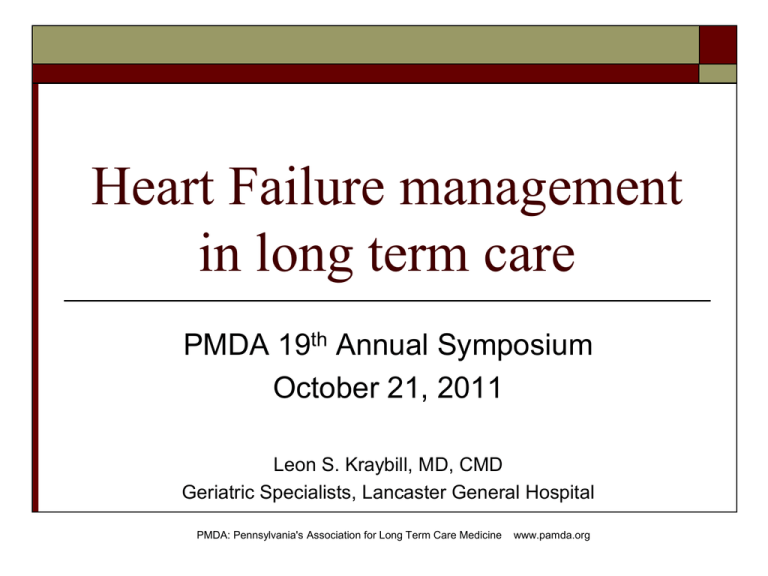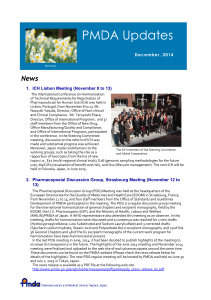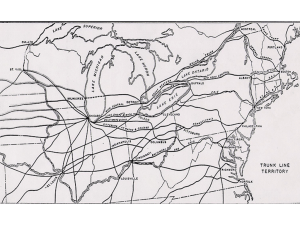Heart failure managment in LTC
advertisement

Heart Failure management in long term care PMDA 19th Annual Symposium October 21, 2011 Leon S. Kraybill, MD, CMD Geriatric Specialists, Lancaster General Hospital PMDA: Pennsylvania's Association for Long Term Care Medicine www.pamda.org Dr. Kraybill has no conflicts of interest or financial benefit from this presentation Digital copy of powerpoint slides and handouts available at: www.pamda.org/2011-handouts/ Email contact: leonkraybill@gmail.com PMDA: Pennsylvania's Association for Long Term Care Medicine www.pamda.org Who gets heart failure? Primarily older people; female > male Over age 65 = 10/100 80% of patients hospitalized for HF are > 65 yo Multiple comorbidities (ie diabetes increases the risk of HF by 80%) PMDA: Pennsylvania's Association for Long Term Care Medicine www.pamda.org Why discuss heart failure? HF is the most common Medicare DRG diagnosis, and consumes more Medicare dollars than any other diagnosis Common cause of death in LTC population 2005: 37% of all Medicare spending, and ~ 50% of inpatient costs. 2008: Estimated US direct and indirect cost of heart failure = $34.8 billion. PMDA: Pennsylvania's Association for Long Term Care Medicine www.pamda.org So……Heart failure is…. Common Expensive Can we alter the course, management, outcome, and cost? PMDA: Pennsylvania's Association for Long Term Care Medicine www.pamda.org LTC disease management Interventions to reduce hospitalizations from nursing homes: Interact II, JAGS April 2011 17-24% reduction in hospital admissions Interact II website: a variety of tools and care pathways to help reduce acute care transfers; including dehydration, fever, mental status changes, heart failure, lower respiratory infection, and UTI --- http://interact2.net/tools.html See attached Early Warning tool, and SBAR PMDA: Pennsylvania's Association for Long Term Care Medicine www.pamda.org Lecture goals Efficient, compassionate, and cost effective management of heart failure in LTC – honoring the wishes of the people who entrust their health decisions to us …..And not push ourselves over the edge in the process PMDA: Pennsylvania's Association for Long Term Care Medicine www.pamda.org Heart failure definition (HF) A complex clinical syndrome that results from any structural or functional disorder that impairs the ability of the ventricles to fill with or eject blood at a rate commensurate with the body's needs Congestive heart failure (CHF) = HF + clinical signs and symptoms of volume overload PMDA: Pennsylvania's Association for Long Term Care Medicine www.pamda.org HF etiology The simple explanation - a failing heart The more complex explanation - a consequence of cardiac muscle remodeling, mediated by neurohormonal responses (rennin-angiotensinaldosterone system) PMDA: Pennsylvania's Association for Long Term Care Medicine www.pamda.org HF is a clinical diagnosis A clinical constellation of symptoms and signs Labs can only confirm clinical suspicions, or demonstrate consequences Older patients may not present typically PMDA: Pennsylvania's Association for Long Term Care Medicine www.pamda.org Start and end with treatment goals Prolongation of life Improvement of quality of life Prevention of exacerbations Prevention of hospital readmissions (and associated cost) Timely provision of palliative care PMDA: Pennsylvania's Association for Long Term Care Medicine www.pamda.org Identify History of heart failure Look at the records! EKG, ECHO, chest x-ray, consults. Suspect if: hypertension, diabetes, CAD, ischemic heart disease, cardiomyopathy, valvular heart disease. Do not be surprised by a diagnosis that is already documented on the record. PMDA: Pennsylvania's Association for Long Term Care Medicine www.pamda.org Symptomatic heart failure: Signs Ascites Hypoalbuminemia Increased jugular venous pressure Positive hepatojugular reflux Laterally displaced apical impulse Peripheral edema not due to venous insufficiency Rales on lung exam Tachycardia Third heart sound (S3) Weight gain PMDA: Pennsylvania's Association for Long Term Care Medicine www.pamda.org Symptomatic heart failure: Symptoms Abdominal symptoms (nausea, abdominal pain or distention) Acute confusional state, delirium Anorexia Decline in functional status Decreased exercise tolerance Decreased food intake Dyspnea at rest Dyspnea on exertion Fatigue Orthopnea Paroxysmal nocturnal dyspnea Unexplained cough, especially at night Weakness PMDA: Pennsylvania's Association for Long Term Care Medicine www.pamda.org What your staff may actually report to you: New or increasing lower extremity swelling Clothing (shoes, pants) appears tight compared previous week Resident appears lethargic or mentally inert Resident is less active Resident has more difficulty breathing with or without exertion Unexplained cough Unexplained weight gain PMDA: Pennsylvania's Association for Long Term Care Medicine www.pamda.org Accurate weights are key! Same time of day Same state of dress Same scale (and staff members that know how to use the scale) How often? What is your facility P&P? PMDA: Pennsylvania's Association for Long Term Care Medicine www.pamda.org Identify and manage risk factors Anemia Dysrhythmia (atrial fibrillation) Hypertension Chronic lung disease CAD Diabetes Excessive alcohol Noncardiac fluid volume overload Sleep disordered breathing Thyroid disease Valvular heart disease Medications – NSAIDs, metformin, glitazones (Actos), calcium channel blockers PMDA: Pennsylvania's Association for Long Term Care Medicine www.pamda.org New York Heart Association HF classification Class I (mild) No limitation of physical activity. Ordinary physical activity does not cause undue fatigue, palpitation, or dyspnea (shortness of breath) Class II (mild) Slight limitation of physical activity. Comfortable at rest, but ordinary physical activity results in fatigue, palpitation, or dyspnea Class III (moderate) Marked limitation of physical activity. Comfortable at rest, but less than ordinary activity causes fatigue, palpitation, or dyspnea Class IV (severe) Unable to carry out any physical activity without discomfort. Symptoms of cardiac insufficiency at rest. If any physical activity is undertaken, discomfort is increased PMDA: Pennsylvania's Association for Long Term Care Medicine www.pamda.org Differentiating types of HF HF with reduced left ventricular ejection fraction (systolic heart failure) Reduced myocardial contractility (CAD, cardiomyopathy) Generally worse prognosis EF cutoff – usually 35-45% More dyspnea, cough, wheezing, fatigue, hypotension, confusion, delirium HF with preserved left ventricular ejection fraction (diastolic heart failure) Decreased left ventricular filling pressures (decreased rate of relaxation, rapid heart rate, ventricular stiffness) Primary cause = hypertension More than 50% of HF patients > 70 yo Right-sided heart failure Right ventricle changes Cause: pulmonary disease, left sided heart failure (most residents with advanced HF have both L and R-sided HF More leg edema, nausea, vomiting, abd ominal sx, dependent edema PMDA: Pennsylvania's Association for Long Term Care Medicine www.pamda.org Decide regarding evaluation Is there another terminal/end-stage condition? Will the evaluation change the management? (would the patient decline treatment?) Will the burden of evaluation be greater than the benefit of treatment? Are there likely to be reasonable treatments? Document, document, document PMDA: Pennsylvania's Association for Long Term Care Medicine www.pamda.org Evaluation tools CXR ECHO Pulse oximetry Labs: CBC, CMP (lytes, calcium, renal, liver), magnesium, TSH, ?lipids To BNP or not to BNP? EKG – angina, dysrhythmia, hx of ischemia PMDA: Pennsylvania's Association for Long Term Care Medicine www.pamda.org Reassess the individual’s goals and realistic options What does the resident want? QOL/comfort vs prolongation of life? Do the resident/family understand the availability of palliative care in LTC? PMDA: Pennsylvania's Association for Long Term Care Medicine www.pamda.org Possible reasons for transfer to hospital Acutely symptomatic and decompensating Unstable cardiac ischemia Limited reasonable treatment options in LTC Resident wants full and aggressive intervention PMDA: Pennsylvania's Association for Long Term Care Medicine www.pamda.org Dietary restrictions Restrictions should be consistent with the resident’s prognosis and quality of life Salt restriction (< 2 grams/day rarely feasible) - may be helpful in moderate to severe heart failure Fluid restriction - hyponatremia, unstable fluid balance despite diuretics Maybe 1.5-2 L daily fluid restriction in advanced heart failure (grades III & IV) – evidence grade B1 Nutritional supplements – generally not indicated CoQ10 - not recommended as a therapy for heart failure by the ACC/AHA PMDA: Pennsylvania's Association for Long Term Care Medicine www.pamda.org Heart failure medications Goal is euvolemia Most patients will need diuretics PMDA: Pennsylvania's Association for Long Term Care Medicine www.pamda.org Low EF HF: Diuretics Thiazide diuretics usually ineffective once CrCl < 30 (? stop @ 50) Loop diuretics improve symptoms and quality of life but do not prolong life Few meaningful clinical differences between different meds Furosemide 20 – 40 mg daily, double until desired diuresis Bumetanide and torsemide may be more bioavailable with an edematous bowel Metolazone 2.5-5 mg prior to furosemide may improve diuresis (but cause more ↓K and ↓Mg When volume has stabilized, seek lowest possible diuretic dose Follow renal function and electrolytes PMDA: Pennsylvania's Association for Long Term Care Medicine www.pamda.org Diuretics: Hypomagnesemia Thiazides and loop diuretics increase Mg loss ↓Mg is often present with ↓K and ↓Na Serum Mg levels are unreliable measures of total body Mg Magnesium gluconate is more soluble, and causes less diarrhea PMDA: Pennsylvania's Association for Long Term Care Medicine www.pamda.org Low EF HF : Angiotensin-converting enzyme inhibitors (ACEIs) Improve quality of life, ↓mortality by 23%, and ↓ risk of hospitalization by 35% First-line agent in HF with EF < 35% Caution: hypotension (?tolerate SBP of 80-90), hyperkalemia, worsening renal function Accept 20-30% rise in creatinine Angiotensin receptor blocker (ARB) if intolerant to ACEI PMDA: Pennsylvania's Association for Long Term Care Medicine www.pamda.org Low EF HF: Beta blockers Good evidence for ↓symptoms and ↑sense of well-being, ↓risk of death (↓30-65%), and ↓hospitalization Indicated for all patients with stable HF due to ↓EF, if no contraindication Should be used in combination with diuretics if fluid retention is present Proven benefit: carvedilol, metoprolol succinate, bisoprolol (metoprolol has less hypotension than carvedilol) Titrate slowly to target dose (see chart) by doubling dose every 2-4 weeks PMDA: Pennsylvania's Association for Long Term Care Medicine www.pamda.org Low EF HF: Beta blockers Initial Dose Target Dose Bisoprolol 12.5 mg daily 10 mg daily Carvedilol immed release 3.125 mg BID 25 mg BID Carvedilol ext. release 10 mg daily 40-80 mg daily Metoprolol ext. release 12.5 mg daily 200 mg daily PMDA: Pennsylvania's Association for Long Term Care Medicine www.pamda.org Low EF HF: Digoxin Less widely used No mortality benefit but some improvement in symptoms and hospitalization Dosage – rarely > 0.125 mg daily Serum levels – usually < 1.0 PMDA: Pennsylvania's Association for Long Term Care Medicine www.pamda.org Low EF HF: Aldosterone antagonists (spironolactone) May help to counter adverse effects of aldosterone in NYHA Class III & IV High risk for ↑K and ↑creatinine (esp if CKD, or on ACEI) Not good clinical data on age > 75-80 yo PMDA: Pennsylvania's Association for Long Term Care Medicine www.pamda.org Low EF HF: Isosorbide dinitrate + hydralazine For African-American residents with HF – ↓ mortality, ↓hospitalizations, ↑ QOL Adjunctive therapy if symptomatic despite standard therapies PMDA: Pennsylvania's Association for Long Term Care Medicine www.pamda.org Low EF HF: Other treatments Calcium channel blockers Nifedipine, diltiazem, verapamil-- ↑HF and mortality Amlodipine & felodipine okay for BP control - no HF benefit Implantable cardioverter defibrillators Risk of sudden death if EF < 35 Do not treat symptoms, only prolong life Cardiac resynchronization therapy Consider if symptomatic HF despite optimal medical management, EF< 35, QRS > 120 ms, Class III or IV, AND prognosis for good functional status > 1 year PMDA: Pennsylvania's Association for Long Term Care Medicine www.pamda.org Low EF HF treatment summary ACEIs - most patients Beta blockers – most patients Diuretics – most patients Aldosterone antagonists – selected patients Digoxin – selected patients Isosorbide dinitrate/hydralazine - selected African-American patients PMDA: Pennsylvania's Association for Long Term Care Medicine www.pamda.org HF with preserved EF (diastolic HF) Evidence based therapy is less clear Goals – decrease fluid overload, and treat elevated filling pressures Control hypertension – perhaps most important Diuretics – if fluid overload ACEI/ARB – less clear benefit (unless concomitant diabetes) – studies lean towards benefit Beta Blockers – sparse data Digoxin – if symptomatic despite other meds PMDA: Pennsylvania's Association for Long Term Care Medicine www.pamda.org HF with preserved EF: Summary Control of systolic and diastolic hypertension Control of ventricular rate in patients with AF Control of pulmonary congestion and peripheral edema with diuretics If ischemia – consider coronary revascularization (if consistent with goals) PMDA: Pennsylvania's Association for Long Term Care Medicine www.pamda.org Peripheral edema management Elevation of extremities Support hose Elastic tubular bandages PMDA: Pennsylvania's Association for Long Term Care Medicine www.pamda.org End of life care in HF Sudden death – up to 60% of HF patients, but can’t predict Gradual deterioration with increasingly frequent acute episodes Explain and offer palliative measures sooner rather than later Discuss the goals of care, code status, intubation, hospitalization Listen and give opportunity for questions Deactivate the defibrillator Dyspnea – diuretics, oxygen, thoracentesis, opiods Hallucinations, delirium – atypical antipsychotics Myoclonus, seizures - lorazepam PMDA: Pennsylvania's Association for Long Term Care Medicine www.pamda.org HF monitoring & assessment protocol & tools Early Warning Tool (general) SBAR – a general preparation tool for the assessing nurse to report any clinical change to provider “BELLS WARN” – HF screening tool for direct caregivers Heart failure in long-term care monitoring protocol Heart failure graphic flow sheet LTC Heart Failure assessment tool Digital versions at www.pamda.org/2011-handouts/ PMDA: Pennsylvania's Association for Long Term Care Medicine www.pamda.org Developing clinical assessment tools and treatment protocols PMDA has interest in developing further If interested, contact Leon Kraybill – leonkraybill@gmail.com Tom Lawrence - tomlawrence@comcast.net PMDA: Pennsylvania's Association for Long Term Care Medicine www.pamda.org Heart failure in LTC Common Expensive in time and money Proactive identification and management will help to prevent subsequent complications and resident distress The resident and the family must be engaged early and throughout the process to identify their goals and wishes This is a collaborative effort – none can do it alone, all must be involved PMDA: Pennsylvania's Association for Long Term Care Medicine www.pamda.org References Heart Failure in the Long-Term Care Setting, AMDA Clinical practice guideline, 2010, www.amda.com/tools/guidelines.cfm Interact2 - from Florida Atlantic University – dedicated to reducing acute care transfers, website contains a variety of tools and resources: http://interact2.net/tools.html Interventions to reduce hospitalizations from nursing homes: Interact II, JAGS April 2011; http://onlinelibrary.wiley.com/doi/10.1111/jgs.2011.59.issue-4/issuetoc Care path: symptoms of congestive heart failure: http://interact2.net/tools.html SBAR: Situation, Background, Assessment, Request- a conceptual tool for supervising nursing staff to assess and report a LTC clinical change: http://interact2.net/tools.html Assessing Heart Failure in Long Term Care Facilities; Harrington, C. University of Iowa Gerontological Nursing Interventions Research Center, Research Translation and Dissemination Core; 2006 Oct 2006 – an EBM practice guideline, 38 page PDF with a variety of tools: http://www.publichealth.uiowa.edu/icmha/outreach/documents/GerontologicalNursingInterventionsResearchCenter.pdf DEFEAT heart failure: assessment and management of heart failure in nursing homes made easy. Ahmed A, Jones L, Hays CI, J Am Med Dir Assoc. 2008 Jul;9(6):383-9. Epub 2008 Jun 3, http://www.ncbi.nlm.nih.gov/pubmed/18585640 Clinical manifestations, diagnostic assessment, and etiology of heart failure in older adults, Ahmed A, Clin Geriatr Med. 2007 Feb;23(1):11-30, http://www.ncbi.nlm.nih.gov/pubmed/17126753 PMDA: Pennsylvania's Association for Long Term Care Medicine www.pamda.org







